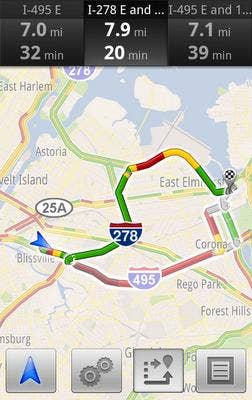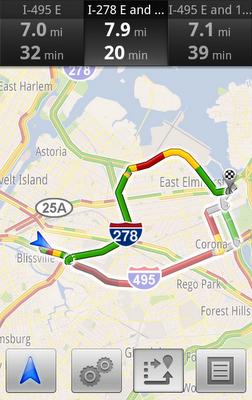Android’s Google Maps App Automatically Tells You How to Beat Traffic

Share
We may never have to get stuck in traffic again. Thank you, Google. A recent update of Google Maps Navigation (Beta), an app for Android devices, tells the program to automatically plot the quickest route for you based on historic as well as current traffic flow. Want to get from Point A to Point D? Well, now Google Maps Navigation knows there's a traffic jam at Point B and will tell you to travel through Point C instead. Brilliant. While previous versions of the app already allowed you to view traffic patterns and choose between various routes, the newest upgrade makes this selection without you having to ask. You really don't have to worry about traffic anymore, the Maps app will do that for you. Best of all, the service is free. Due to the availability of reliable traffic data, it's currently only ready for Android users in North America and the EU, but this represents more than 35 million miles driven each day! By letting smart phone users avoid traffic jams, Google is helping to optimize traffic flow, and if adopted on a large scale all drivers could benefit. Though the app is still in Beta, and only available on Android phones at the moment, it's a sign that highway congestion may be a frustration we could conquer in the near future.
Like many recent software innovations, the new optimized traffic router for Google Maps Navigation is really just an amalgamation of previously successful technologies. Google Maps (both on Android platforms and via the web) have already been able to visualize current traffic levels. In fact, most online map programs can do this. A few of the newest onboard GPS navigation systems can do this as well. Not only that, but as I mentioned above, Google Maps Navigation already let you choose between alternate routes based on traffic congestion. Watch the following video clip to see that level of the app in action:
All Google has done is make this alternative routing process automatic. Simple as that. Yet changing the default preference to compensate for current traffic is a great sign of things to come. Imagine Google (or any company with a map to offer) tracking how many users have requested traffic information along a specific route over a period of time - say the last hour. After some calibrating studies, Google could estimate how many of those users would eventually take the prescribed route. Not only might they be able to predict influxes of traffic, they could navigate the next wave of users to avoid the traffic that will be created by the last group. As applications like Google Maps Navigation improve they'll probably find many more such scenarios where they can optimize traffic. With enough user adoption, and with the data analysis that Google (and their competitors) have already proven they possess, we could create a system that could actively direct enough traffic to avoid major jams.
Be Part of the Future
Sign up to receive top stories about groundbreaking technologies and visionary thinkers from SingularityHub.


That's just the beginning. Remember that companies like Google are spear-heading the push towards autonomous cars. I think that social and legal hurdles will slow our adoption of these robot vehicles for the foreseeable future, but eventually we will accept them at some level. When we do allow computers to drive our automobiles, we're going to open up a whole new realm of optimized traffic flow. Car by car we could plan routes that would minimize transit times - not only for the riders in the vehicle, but for all the other passengers on the road. Forget major traffic jams, we could avoid a large portion of congestion altogether.
Achieving such a driving utopia will require a large percentage of drivers on the road to adopt computer guided, traffic-aware, navigation. If Google Maps Navigation catches on in North America and Europe then maybe that utopia will arrive there first. In my opinion, however, it seems likely that heavy-handed state-sponsored programs may be the key to get nations there faster. With 10 mile traffic jams providing motivation, and with a penchant for upgrading infrastructure, China certainly is a good bet. We'll have to wait and see who gets their act together quickest. If you have an Anrdoid phone congratulations on being able to drive with less frustration. For the rest of us, let's hope that similar technologies become available soon. If there's anything I hate more than getting stuck in traffic, it's knowing I could have avoided it.
[image and video credits: Google]
Source: google blog
Related Articles

This Portable Wind Turbine Is the Size of a Water Bottle and Charges Devices in Under an Hour

Mojo Vision’s New Contact Lens Brings Seamless Augmented Reality a Step Closer
The Weird, the Wacky, the Just Plain Cool: Best of CES 2020
What we’re reading
